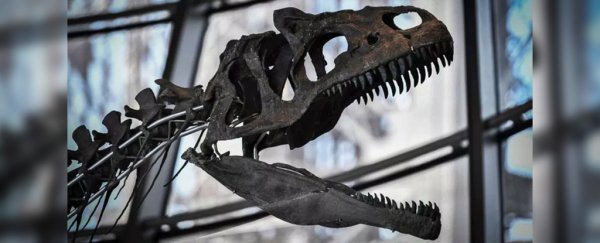By the time the scientists had catalogued the last bone, they realized they might be staring at the discovery of a lifetime - the 70 percent intact fossil of a carnivorous creature as long as a telephone pole that may represent a new kind of dinosaur.
But that is not all that they unearthed.
Five years after it was discovered in Wyoming, the bones of the creature - it still has no name - have been sold at auction to a private art collector for US$2.36 million on Monday, exhuming a debate that is at once economic, political and ethical.
Should the fate of a 150-million-year-old fossil lie in the hands of one deep-pocketed person who happens to be the highest bidder? Or should it be controlled by a museum or another authority who can ensure that it can be studied by scientists and preserved for posterity?
"An auction is a device to get the highest possible price out of something," P. David Polly, the president of the Society of Vertebrate Paleontology and a professor of sedimentary geology at Indiana University, told Live Science.
"And, generally speaking, even big museums don't have budgets for purchasing specimens."
The dinosaur in question was dug up between 2013 and 2015 and may be a relative of the allosaurus, a Jurassic-era biped that was among the earliest and most widely studied dinosaur discoveries, according to Live Science.
Eric Mickeler, who works for the Aguttes auction house that organized the bidding battle, told Agence France-Presse that the dinosaur is "the only one of its species" that has been discovered.
Eric Geneste, a dinosaur expert, told the news organization that scientists can't classify the dino as an allosaurus yet. The number of teeth don't match up, and the new dinosaur has longer shoulder blades.
"In fact, there are as many differences between it and an allosaurus as between a human and a gorilla," he added.
Obviously, the Wyoming fossil needs additional study, scientists say. But paleontologists worry they may never get a close enough look at it - because the fossil belongs to a private buyer, not a person or an organization bound by the mores and rules of the greater scientific community.
A few weeks ago, the Society of Vertebrate Paleontology, which represents more than 2,000 students and professionals, asked the auction house to scuttle the sale.
"Scientifically important vertebrate fossils are part of our collective natural heritage and deserve to be held in public trust," the society said in an open letter.
"Fossil specimens that are sold into private hands are lost to science. Even if made accessible to scientists, information contained within privately owned specimens cannot be included in the scientific literature because the availability of the fossil material to other scientists cannot be guaranteed, and therefore verification of scientific claims (the essence of scientific progress) cannot be performed."
The person who bought the dinosaur doesn't exactly plan to make it the centerpiece of a fountain in his French villa, auctioneers said. The buyer, identified only as a British businessman, has pledged to lend it to a museum and said that it will be made available to scientists.
"Everyone will be able to see it, it will soon be lent to a museum, it will be studied by scientists, everything is perfect," auctioneer Claude Aguttes told Reuters.
But the buyer has remained at least publicly silent on another issue that is vexing scientists: If it is a new species, who gets to name it?
Naming new species "is governed by the International Code of Nomenclature, which award priority to the first validly published name, not to the owner of the specimen that formed the basis of that name," the society said.
Still, it's unclear whether the owner was influenced by the near-promise made on page 51 of the auction brochure.
"The buyer will be acquiring the skeleton of a dinosaur which could be named after them or after one of their children, with the agreement of the scientist who formally describes the species," the auction brochure states.
"One's name would thus remain forever linked to a significant cultural and scientific event."
2018 © The Washington Post
This article was originally published by The Washington Post.
